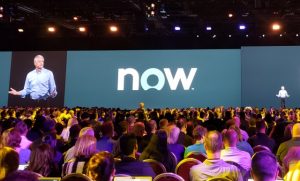Enterprise software vendor ecosystems are nothing new. Even in the early days of enterprise computing when a handful of mainframe vendors dominated the market, each of them worked with partners, including smaller vendors with complementary offerings as well as various types of consultants who could aid with implementation.

Vendor conferences are a splendid way to see such ecosystems in action, and I’ve written about several recently, including my takes on the VMware ecosystem, IBM ecosystem, and Dell Technologies ecosystem.
IBM’s ecosystem, in fact, is the granddaddy of all of them, having gone through the mainframe era, the ‘IBM compatible’ PC days, WebSphere middleware in the 2000s, and now the IBM Cloud/Watson ecosystem.
One informal way of measuring the vibrancy of an ecosystem is to look at the attendance of a vendor conference where ecosystem partners exhibit. At IBM Think, Big Blue’s most recent conference, customers were in a distinct minority, signaling challenges with the standard ecosystem model.
All of these ecosystems consist of tiers of partners, typically ranked as silver, gold, etc. – the rank corresponding to how much joint business they do as well as how much money they pay to the host vendor for the privilege.
This standard model, therefore, largely follows a ‘hub-and-spoke’ topology, with multitudes of smaller players in orbit, partnering with the one large one holding court at the center of its own solar system.
Ecosystem partners are welcome to partner with each other, of course, but the sun in the middle doesn’t particularly care whether two of its planets are in cahoots with each other.
New Model for Enterprise Ecosystems
It could be argued that Salesforce broke this hub-and-spoke mold for enterprise software ecosystems.
What made Salesforce’s ecosystem different from the ones that came before was the fact that the company offered a platform – and furthermore, that platform was in the cloud. As a result, ecosystem partners could either integrate with the platform or actually run on the platform itself.
Ecosystems thus became more than business relationships – they became fully integrated technology relationships as well. And the glue holding the entire architecture together? Data.
Read the entire article at https://www.forbes.com/sites/jasonbloomberg/2018/05/11/servicenow-drives-platform-innovation-with-next-generation-ecosystem/.
Intellyx publishes the Agile Digital Transformation Roadmap poster, advises companies on their digital transformation initiatives, and helps vendors communicate their agility stories. As of the time of writing, IBM, LogicMonitor, and ServiceNow are Intellyx customers. None of the other organizations mentioned in this article are Intellyx customers. ServiceNow covered Jason Bloomberg’s expenses at ServiceNow Knowledge, a standard industry practice. Image credit: Jason Bloomberg.



